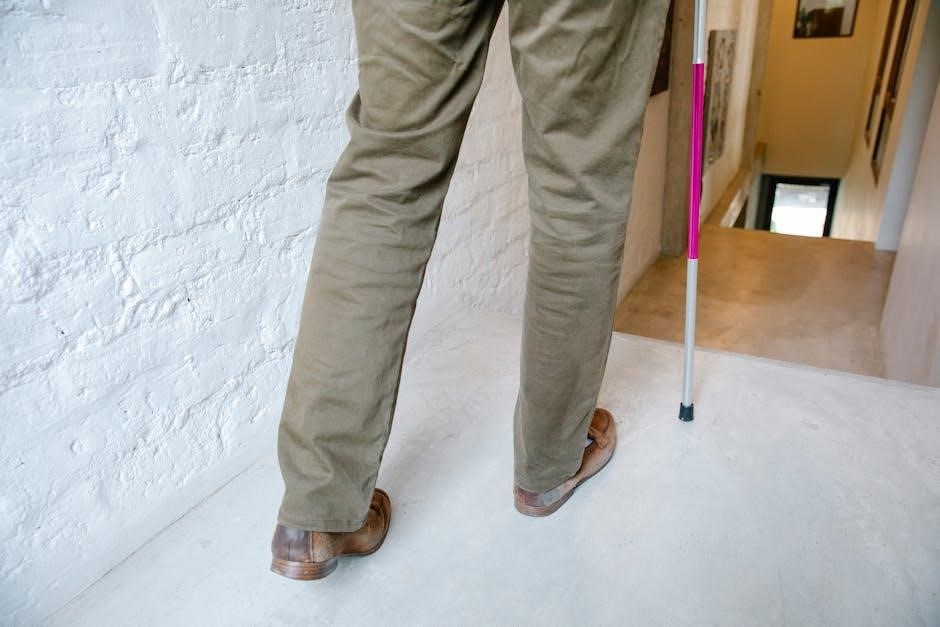Floor guides are essential components for sliding doors, ensuring smooth operation and stability; They provide alignment, prevent door movement, and enhance safety while complementing modern interior designs.

1.1 Definition and Purpose of Floor Guides
Floor guides are devices installed on floors to direct sliding doors smoothly. Made from materials like steel, stainless steel, or aluminum, they ensure proper alignment, stability, and safety. Their purpose is to prevent door misalignment, reduce wear, and enhance functionality while complementing interior designs.
1.2 Importance of Floor Guides in Modern Design
Floor guides play a crucial role in modern design by ensuring seamless functionality and aesthetic appeal. They complement interior styles, enhance safety, and provide smooth door operation, making them indispensable in contemporary spaces for both residential and commercial applications.
Types of Floor Guides
Floor guides come in various styles, including stainless steel, adjustable models, and U-shaped designs. They offer versatility, durability, and aesthetic appeal for different door systems and applications.
2.1 Glass Floor Guides
Glass floor guides are designed for sliding glass doors, offering a sleek and modern appearance. They feature adjustable mechanisms to accommodate different glass thicknesses, ensuring smooth operation and stability. Made from durable materials like stainless steel, these guides are both functional and aesthetically pleasing, enhancing the overall design of glass door systems while providing reliable performance.
2.2 Timber Floor Guides
Timber floor guides are ideal for sliding timber doors, offering a natural aesthetic that complements wooden interiors. Available in various styles and finishes, they are crafted from durable materials like solid wood or wood composites. These guides provide stability and smooth door operation while blending seamlessly with traditional or modern design schemes, enhancing functionality and beauty in residential spaces.
2.3 Barn Door Floor Guides
Barn door floor guides are designed for rustic or country-style sliding doors, offering durability and a vintage charm. Typically U-shaped or adjustable, they accommodate various door styles and thicknesses. Made from robust materials like steel or nylon, these guides ensure smooth operation and stability. Ideal for DIY projects, they provide a flush, flat bottom design for seamless integration into any setting.

Technical Specifications
Adjustable floor guides accommodate varying glass thicknesses (8-12mm), ensuring precise alignment and stability. They feature variable settings for different door systems, making installation straightforward and efficient.
3.1 Adjustable Floor Guides for Different Glass Thicknesses
Adjustable floor guides are designed to accommodate varying glass thicknesses, typically ranging from 8mm to 12mm. They feature robust constructions with variable adjustment mechanisms, ensuring precise alignment and stability for glass doors. These guides are crafted from durable materials like steel or stainless steel, offering versatility and reliability in modern sliding door systems.
3.2 Materials Used in Floor Guides (Steel, Stainless Steel, Aluminum)
Floor guides are crafted from robust materials such as steel, stainless steel, and aluminum. Steel offers durability and strength, while stainless steel provides corrosion resistance, ideal for humid environments. Aluminum is lightweight yet sturdy, making it suitable for modern designs. These materials ensure longevity and reliability, catering to various door types and applications.
3.3 Weight Capacity and Load-Bearing Limits
The weight capacity of floor guides varies, typically ranging from 176 lbs for steel models to lighter loads for aluminum. Proper installation and material choice ensure durability. Exceeding load limits can compromise stability and safety, so adhering to manufacturer specifications is crucial for optimal performance and longevity.

Installation and Maintenance
Installation and maintenance of floor guides require specific tools and careful planning. Proper alignment, regular cleaning, and securing hardware ensure smooth operation and longevity.

4.1 Tools and Materials Required for Installation
Installing floor guides requires a miter box, hacksaw, screwdrivers, and drills. Materials include screws, spacers, bolts, and adjustment wrenches. Ensure all tools are readily available for a smooth setup process.
4.2 Step-by-Step Installation Guide
Measure the door’s bottom edge, mark the floor accordingly, and drill pilot holes. Align the floor guide with marks, secure it using screws, and adjust for proper door thickness. Tighten all bolts and test the door’s smooth operation to ensure proper alignment and functionality.
4.3 Maintenance Tips for Longevity
Regularly clean floor guides to prevent debris buildup. Lubricate moving parts to reduce friction and wear. Check alignment and tighten screws periodically. Inspect for damage and replace worn components promptly. For glass guides, ensure proper adjustment to avoid scratches. Schedule professional inspections for complex systems to maintain optimal performance and longevity.
Design Considerations
Floor guides are crafted in various styles to suit modern aesthetics. With finishes like stainless steel, glass, and timber, they seamlessly integrate into contemporary and traditional interiors.
5.1 Aesthetic Styles and Finishes
Floor guides come in diverse aesthetic styles, from sleek stainless steel to elegant glass and timber designs. Finishes like brushed, polished, or powder-coated options allow seamless integration with modern or traditional interiors.
5.2 Functional Design Elements
Functional design elements of floor guides include adjustable mechanisms, anti-slip features, and secure locking systems. These ensure smooth door operation, prevent slipping, and provide stability. Adjustability accommodates various door thicknesses, while materials like steel and nylon offer durability and quiet performance, enhancing both safety and usability in diverse settings.
Safety Features
Safety features include anti-slip surfaces and secure locking mechanisms, ensuring doors remain stable and prevent accidents. These elements provide enhanced protection and reliability in various applications.
6.1 Anti-Slip and Secure Locking Mechanisms
Floor guides often feature anti-slip surfaces to prevent door movement and slipping; Secure locking mechanisms ensure doors remain in place, enhancing stability and safety. These designs minimize accidents and provide reliable operation, especially in high-traffic areas or environments with varying conditions. Such features are crucial for maintaining functionality and user safety, ensuring optimal performance over time.
6.2 Load Capacity and Stability
Floor guides are designed to support varying door weights, ensuring stability and preventing door sagging. Materials like steel or stainless steel enhance durability, while adjustable features accommodate different loads. Proper installation and alignment are crucial to maintain load capacity, ensuring smooth door operation and preventing potential hazards. Stability is key to long-term functionality and safety in any setting.
Accessories and Additional Components
Accessories like spacers and mounting hardware enhance functionality, while optional enhancements such as adjustable rollers or decorative covers allow for customization to meet specific design or practical needs.
7.1 Spacers and Mounting Hardware
Spacers and mounting hardware are crucial for proper installation. They ensure the floor guide is securely fastened, maintaining alignment and preventing door wobble. Available in various materials like steel or aluminum, these components provide durability and versatility, adapting to different door types and thicknesses for a stable and efficient sliding door system.
7.2 Optional Enhancements for Customization
Optional enhancements allow customization of floor guides to match specific designs. Features like adjustable spacers, decorative finishes, and stylish covers can be added. These enhancements not only improve functionality but also elevate the aesthetic appeal, ensuring the floor guide blends seamlessly with various interior styles and door systems for a polished look;

Frequently Asked Questions
Common queries include whether floor guides are necessary, how to choose the right type, and maintenance tips. These questions help users understand functionality and installation requirements effectively.
8.1 Are Floor Guides Necessary for Sliding Doors?
Floor guides are crucial for sliding doors as they ensure smooth operation, prevent door misalignment, and provide stability. They enhance safety by keeping doors securely in place, especially for heavy or large sliding doors, making them a fundamental component for both functionality and durability in modern designs.
8.2 How to Choose the Right Floor Guide for Your Door
Selecting the right floor guide involves considering door type, weight, and thickness. Measure the door’s dimensions and ensure compatibility with the floor guide’s adjustment range. Choose materials like steel or aluminum for durability. Consider aesthetic style and load-bearing capacity to ensure stability and safety. Always check compatibility with your door system for optimal performance.

Case Studies and Applications
Floor guides are widely used in residential and commercial settings, enhancing sliding door functionality in modern designs while ensuring durability and stability across various applications.
9.1 Residential Applications
Floor guides are widely used in homes for sliding glass, timber, and barn doors, ensuring smooth operation. They support door systems, prevent misalignment, and enhance interior aesthetics. Residential applications often prioritize durability, noise reduction, and sleek designs, making floor guides a practical and stylish solution for modern living spaces.
9.2 Commercial and Industrial Use Cases
Floor guides are crucial in commercial and industrial settings, ensuring smooth sliding door operations. They are used in warehouses, hospitals, and offices, supporting heavy-duty doors and ensuring safety. Their durability and load-bearing capacity make them ideal for high-traffic areas, enhancing functionality and efficiency in industrial environments.
Floor guides have evolved significantly, offering durability and aesthetic appeal. Future trends include eco-friendly materials, smart technology integration, and innovative designs, enhancing functionality and modern spaces.
10.1 Evolution of Floor Guide Technology
Floor guide technology has advanced from basic alignment tools to sophisticated systems. Early versions used simple materials, while modern guides feature adjustable mechanisms, durable finishes, and smart integration, enhancing both functionality and design. Innovations like variable glass thickness adjustment and barn door guides reflect the industry’s commitment to versatility and user-centric solutions.
10.2 Emerging Trends in Floor Guide Design
Emerging trends in floor guide design emphasize durability, aesthetics, and functionality. High-quality materials like stainless steel and aluminum are favored for their sleek appearance and longevity. Adjustable mechanisms and smart integration with modern door systems are gaining popularity. Customizable finishes and designs cater to diverse architectural styles, blending seamlessly with contemporary interiors while maintaining practicality.
